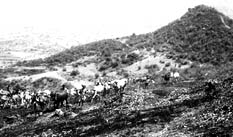Soiled future
 whenever the season's crop is harvested, a part of the surface soil is swept away by the wind. In this process, the world is gradually losing fertile soil. Every year, farmers harvest their crops, they leave their lands exposed to rain and storm. Due to this, agricultural soil is being eroded with a rate of nearly one per cent every year, says ecologist Stuart Pimm of the University of Tennessee in Knoxville, usa ( New Scientist , Vol 157, No 2117).
whenever the season's crop is harvested, a part of the surface soil is swept away by the wind. In this process, the world is gradually losing fertile soil. Every year, farmers harvest their crops, they leave their lands exposed to rain and storm. Due to this, agricultural soil is being eroded with a rate of nearly one per cent every year, says ecologist Stuart Pimm of the University of Tennessee in Knoxville, usa ( New Scientist , Vol 157, No 2117).
To increase the productivity of the remaining land, farmers use high-tech solution such as chemical fertilisers and machines to plough up compacted soil. Till today, these methods have helped meet the world's food requirements, but not without huge environmental and financial costs.
In such circumstances, how could it be if cereal crops are only required to be replanted once in every few years instead of annually? Perennial crops would hold the soil in place with their extensive root systems. Roots also keep soil from compacting to the point where water and new roots can no longer penetrate. Scientists think that the correct mixture of plants might even start the long process of soil regeneration.
Nearly 20 years ago, Wes Jackson and his colleagues at the Land Institute in Salina, Kansas, usa , had envisioned the future implications. And since then they are trying to develop such plants which could put an end to all these problems. At present, the task looks a bit tough. But if they succeed, there may be an agricultural revolution in future.
Today, all the domesticated cereals are members of the grass family Poaceae . However, perennial species are required to come from their wild relatives. Ironically, no wild species of cereal grain has been domesticated since farming became established nearly 6,000 years ago.
Apart from protecting soil from erosion, perennial species offer several other advantages such as retaining more nutrients than annual crops, and thus needing fewer fertilisers. These species are naturally more resistant to drought, disease and pests than cultivated plants. Such strengths of these wild species have been encouraged to develop alternatives of today's crops.
Jackson and his colleagues started collecting the wild relatives of common crops from native grass prairie. Considered to be the original creators of fertile soils in the us , these prairie plants are dominated by perennials. The researchers have identified four functional groups of pairie plants
Related Content
- From climate risk to resilience: unpacking the economic impacts of climate change in Kenya
- Nature's frontiers: achieving sustainability, efficiency, and prosperity with natural capital
- Global assessment of soil carbon in grasslands: from current stock estimates to sequestration potential
- Global peatlands assessment: the state of the world’s peatlands
- Our climate's secret ally: uncovering the story of nature in the IPCC Sixth Assessment Report
- Final assessment report on the environmental carrying capacity study for expansion of 2 X 600 MW Udupi power plant, Karnataka, 24/01/2022
